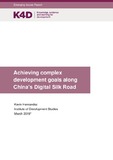| dc.contributor.author | Hernandez, Kevin | |
| dc.date.accessioned | 2019-03-08T16:37:34Z | |
| dc.date.available | 2019-03-08T16:37:34Z | |
| dc.date.issued | 2019-03-08 | |
| dc.identifier.citation | Hernandez, K. (2019). Achieving complex development goals along China’s Digital Silk Road. K4D Emerging Issues Report. Brighton, UK: Institute of Development Studies. | en |
| dc.identifier.uri | https://opendocs.ids.ac.uk/opendocs/handle/20.500.12413/14396 | |
| dc.description.abstract | This report is divided into four main parts. Section 2 summarises the general literature on ICTs and the SDGs to illustrate both synergies and potential trade-offs between accelerating ICT adoption and achieving complex development goals. It first identifies key SDGs that explicitly call for greater ICT adoption and access to ICT infrastructure, and then covers the literature in five key areas: (i) the relationship between ICTs and economic growth and using ICTs to achieve development outcomes; (ii) the relationship between ICTs and inequality and the “leave no one behind” (LNOB) agenda; (iii) digital barriers and inequality that go beyond the provision of infrastructure; (iv) ICTs and the future of work; and (v) ICTs and environmental sustainability. Although digital technologies could be a force for good and help achieve the SDGs, this trajectory is not automatic, nor is it a given, and in many regards current trends can lead to the contrary. Achieving the SDGs in an increasingly digital world will necessarily mean reversing negative trends and finding ways to deal with some of the challenges emerging from greater ICT adoption. This will require actions above and beyond building infrastructure from a wide range of actors.
Section 3 covers the “digital Silk Road” and analyses it according to the literature on the interactions between ICTs and the SDGs covered in the previous section. It starts by covering some of the policy objectives of the digital Silk Road. It then lightly analyses potential SDG contributions and challenges on some of the main elements of the digital Silk Road including: ICT infrastructure, the growing market share of Chinese device manufacturers, the promotion of “inclusive globalisation” through e-commerce, the exportation of “smart cities” to countries along the BRI, the expansion of China’s internet giants, and the Digital Belt and Road Program Science Plan. Overall, Section 3 highlights that although Chinese actors in the BRI often frame their activities as having only positive SDG impacts, they fail to consider the potential challenges arising from a greater adoption of ICTs and digitisation including: the potential of increasing inequalities, the implications for leaving no one behind, energy consumption and e-waste among others.
Section 4 concludes and provides policy recommendations for traditional development actors seeking to engage with the digital Silk Road. It suggests that traditional donors should: (a) use their convening power to bring together a diverse group of stakeholders to work through the complexities of achieving the SDGs as ICTs continue to spread; (b) be honest knowledge brokers for developing country governments about ICTs and their synergies and trade-offs with achieving the SDGs; (c) work on providing offline channels so the unconnected do not fall further behind; and (d) focus on the future of work which largely gets overlooked in the digital Silk Road. However, direct partnerships in digital BRI projects may be risky for traditional development donors due to concerns that may not bode well with their citizens about the digital Silk Road spreading an unfree internet and technologies that could be used to empower governments while disempowering citizens. | en |
| dc.language.iso | en | en |
| dc.publisher | IDS | en |
| dc.relation.ispartofseries | K4D Emerging Issues Report; | |
| dc.rights | This report was prepared for the UK Government’s Department for International Development (DFID) and its partners in support of pro-poor programmes. It is licensed for non-commercial purposes only. K4D cannot be held responsible for errors or any consequences arising from the use of information contained in this report. Any views and opinions expressed do not necessarily reflect those of DFID, K4D or any other contributing organisation. © DFID - Crown copyright 2019. | en |
| dc.rights.uri | https://www.nationalarchives.gov.uk/doc/open-government-licence/version/3/ | en |
| dc.subject | Development Policy | en |
| dc.subject | Technology | en |
| dc.title | Achieving Complex Development Goals Along China’s Digital Silk Road | en |
| dc.type | Emerging Issues Reports | en |
| dc.rights.holder | © DFID - Crown copyright 2019 | en |
| dcterms.dateAccepted | 2019-03-08 | |
| rioxxterms.funder | Department for International Development, UK Government | en |
| rioxxterms.identifier.project | K4D | en |
| rioxxterms.version | VoR | en |
| rioxxterms.funder.project | 238a9fa4-fe4a-4380-996b-995f33607ba0 | en |

